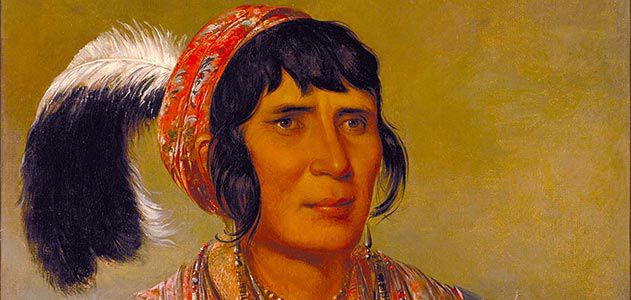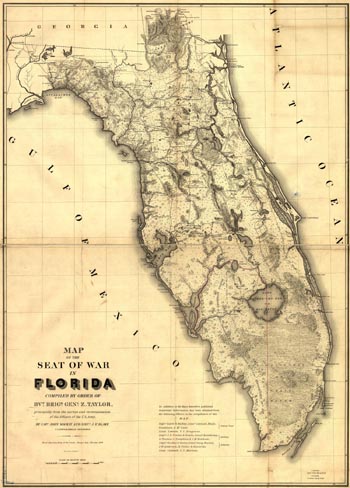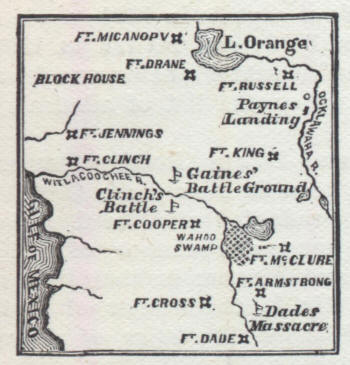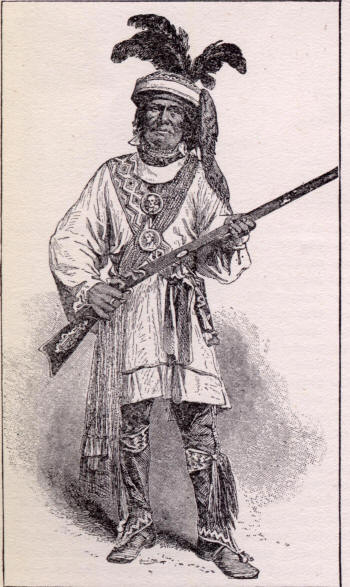About Publications Library Archives
heritagepost.org

Preserving Revolutionary & Civil War History

Preserving Revolutionary & Civil War History

 Seminole Indians, a tribe of Florida Indians, made up of two bands of the Creeks, who withdrew from the main body in 1750, and remnants of tribes who had come in contact with the Spaniards. The Seminoles were hostile to the Americans during the Revolutionary War and afterwards. The Creeks claimed them as a part of their nation, and included them in a treaty with the United States in 1790; but the Seminoles repudiated it and made war upon the Americans, and affiliated with the Spaniards in 1793. They were also enemies of the United States in the War of 1812, when they were under Spanish rule. At that time they were divided into seven clans, and were rich in live-stock and negro slaves. The Creek War led to trouble between the Seminoles and the Georgians, and in 1817 they began hostilities.
Seminole Indians, a tribe of Florida Indians, made up of two bands of the Creeks, who withdrew from the main body in 1750, and remnants of tribes who had come in contact with the Spaniards. The Seminoles were hostile to the Americans during the Revolutionary War and afterwards. The Creeks claimed them as a part of their nation, and included them in a treaty with the United States in 1790; but the Seminoles repudiated it and made war upon the Americans, and affiliated with the Spaniards in 1793. They were also enemies of the United States in the War of 1812, when they were under Spanish rule. At that time they were divided into seven clans, and were rich in live-stock and negro slaves. The Creek War led to trouble between the Seminoles and the Georgians, and in 1817 they began hostilities.
Towards the close of that year a motley host, composed chiefly of Seminoles and runaway negroes, began murderous depredations upon the frontier settlements of Georgia and Alabama. General E. P. Gaines, then in command of the garrison at Fort Scott, on the north bank of the Flint, was ordered to suppress these outrages. He demanded of the Indians on the opposite bank the surrender of certain alleged murderers; but they refused to give them up, on the ground that the Georgians had been the first aggressors.
 Under authority from the War Department to expel these Indians from the lately ceded Creek lands north of the Florida line, Gaines attacked an Indian village, a few miles below Fort Scott, in the night. Three or four of the inhabitants were killed or captured, the rest escaping into the woods. In another skirmish soon afterwards two or three were killed on both sides. This movement of Gaines aroused the fiercest anger of the Indians, who, it was ascertained, were incited by British subjects protected by the Spanish authorities in Florida. The Indians revenged the attacks of Gaines by waylaying a boat ascending the Apalachicola with supplies for Fort Scott. Of forty men and a number of women and children on board, all were killed except six men and one woman. Gaines was in a perilous position. He received orders to carry the war into Florida if necessary, with directions, however, that if the Indians took refuge under any Spanish fort, not to attack it, but report to the War Department. For his own protection he called out a body of Georgia, militia; and when news of the disaster on the Apalachicola reached the government, General Jackson, who commanded in the Southern Department, was ordered (January, 1818) to take the field in person.
Under authority from the War Department to expel these Indians from the lately ceded Creek lands north of the Florida line, Gaines attacked an Indian village, a few miles below Fort Scott, in the night. Three or four of the inhabitants were killed or captured, the rest escaping into the woods. In another skirmish soon afterwards two or three were killed on both sides. This movement of Gaines aroused the fiercest anger of the Indians, who, it was ascertained, were incited by British subjects protected by the Spanish authorities in Florida. The Indians revenged the attacks of Gaines by waylaying a boat ascending the Apalachicola with supplies for Fort Scott. Of forty men and a number of women and children on board, all were killed except six men and one woman. Gaines was in a perilous position. He received orders to carry the war into Florida if necessary, with directions, however, that if the Indians took refuge under any Spanish fort, not to attack it, but report to the War Department. For his own protection he called out a body of Georgia, militia; and when news of the disaster on the Apalachicola reached the government, General Jackson, who commanded in the Southern Department, was ordered (January, 1818) to take the field in person.
With 1,000 Tennessee mounted volunteers, Jackson hastened to the aid of Gaines, and reached Fort Scott March 9, after a march of 400 miles. These, with a body of Georgia militia and 1,000 regulars at Fort Scott, made a force sufficient to invade Florida if necessary. Jackson was joined by friendly Creeks, under their chief—McIntosh—who held the commission of a brigadier-general in the United States army. So short were supplies in that region that Jackson had to depend upon provision-boats ascending the Apalachicola from New Orleans, and, as a depot for these supplies, he built a new fort on the site of the old Negro Fort, and called it Fort Gadsden. On March 20 he marched eastward against the Seminole villages in the vicinity of the present city of Tallahassee, being joined on the way by a fresh body of friendly Creeks (April 1) and a few more Tennessee volunteers. The Seminoles made but slight resistance. Their villages were burned, and a considerable spoil in corn and cattle was obtained. Unrestrained by such orders as Gaines had received, and satisfied that the Seminoles were continually encouraged to make war by the British and Spaniards, he proceeded to the Spanish post of St. Mark’s, the only one in that region, and its surrender being refused on his demand, he took it by force, though without bloodshed.
There he found Alexander Arbuthnot, a Scotch trader with the Seminoles, whom he suspected of mischief, and held him a prisoner. An American armed vessel on the coast having hoisted the British flag, two refugee Creek chiefs were enticed on board, one of whom, the Prophet Francis, had lately visited England and excited some sympathy there. These chiefs Jackson hanged. From St. Mark’s Jackson marched against an Indian town on the Suwanee River and burned it. The Indians and negroes there were led in its defense by Robert Ambrister, connected with Arbuthnot in trading enterprises, and he, too, was made prisoner. Returning to St. Mark’s, Arbuthnot and Ambrister were tried (April 26) by a court-martial. Both were found guilty of stirring up the Indians to war, and executed.
Meanwhile one or two other Indian towns were destroyed by Georgians; and a rumor reaching Jackson of encouragement being given by the Spanish governor at Pensacola to Indian raids into Alabama, the general marched for that place. He was met on the way by a protest from the governor against the invasion of Florida, and his determination to resist it by force. But Jackson pressed on, and entered Pensacola the next day (May 24), with only a show of resistance. The governor fled to the fort at the Barrancas, which Jackson assailed with cannon, when the alarmed magistrate thought it prudent to surrender (May 27). The Spanish authorities and troops were sent to Havana. When Jackson’s proceedings in Florida were made known in Washington the Spanish minister (Don Onis) protested against this invasion of Spanish territory. Jackson had ended the Seminole War, and the object of the government being accomplished, the President offered to restore Pensacola at once, and St. Mark’s whenever Spain should have a force there competent to control the neighboring Indians. The Secretary of State (J. Q. Adams) justified Jackson’s conduct, holding that the war with the Seminoles had originated entirely in the instigations of Arbuthnot and Ambrister, with the encouragement of the Spanish authorities.
 By a treaty made in 1823, the Seminoles gave up nearly all their territory for a consideration; but some refused to accede, and were allowed to remain on small reserves, with the understanding that they were to hunt and deliver fugitive slaves. Dissatisfaction followed, and the Georgians clamored for their removal. An attempt to remove them by force caused the kindling of a second war in 1835. In his annual message in December, 1830, President Jackson recommended the devotion of a large tract of land west of the Mississippi River to the use of the Indian tribes yet remaining east of it. Congress passed laws in accordance with this recommendation, and in May, 1832, some of the chiefs of the Creeks and Seminoles, in council, agreed to remove. Other chiefs and the great body of the nation refused to comply with the terms of the treaty, and trouble ensued. In 1834 the President sent Gen. Wiley Thomson to Florida to make a forcible removal of the Seminoles if necessary. OSCEOLA stirred up the nation to resistance. One day his insolent bearing and offensive words in Thomson’s presence caused that general to put the chief in irons, and in prison, for a day. Osceola’s wounded pride called for vengeance, and it was fearfully wrought during a war that lasted about seven years. By bravery, skill, strategy, and treachery, he overmatched United States troops sent against him and commanded by some of the best officers in the service; but he was secured and subdued finally by an act of perfidy on the part of a United States officer.
By a treaty made in 1823, the Seminoles gave up nearly all their territory for a consideration; but some refused to accede, and were allowed to remain on small reserves, with the understanding that they were to hunt and deliver fugitive slaves. Dissatisfaction followed, and the Georgians clamored for their removal. An attempt to remove them by force caused the kindling of a second war in 1835. In his annual message in December, 1830, President Jackson recommended the devotion of a large tract of land west of the Mississippi River to the use of the Indian tribes yet remaining east of it. Congress passed laws in accordance with this recommendation, and in May, 1832, some of the chiefs of the Creeks and Seminoles, in council, agreed to remove. Other chiefs and the great body of the nation refused to comply with the terms of the treaty, and trouble ensued. In 1834 the President sent Gen. Wiley Thomson to Florida to make a forcible removal of the Seminoles if necessary. OSCEOLA stirred up the nation to resistance. One day his insolent bearing and offensive words in Thomson’s presence caused that general to put the chief in irons, and in prison, for a day. Osceola’s wounded pride called for vengeance, and it was fearfully wrought during a war that lasted about seven years. By bravery, skill, strategy, and treachery, he overmatched United States troops sent against him and commanded by some of the best officers in the service; but he was secured and subdued finally by an act of perfidy on the part of a United States officer.
The first blow was struck in the December of 1835. Osceola, with all the cunning of a Tecumseh and the heroism of a Philip, began the war by an act of perfidy. He had agreed to fulfill treaty stipulations, and to send some horses and cattle to General Thomson; but at the very time he was to do so he was, with a small war-party, murdering the unsuspecting white inhabitants on the borders of the everglades, a region mostly covered with water and grass, and affording a secure hiding-place for the Indians. At that time General Clinch was occupying Fort Drane with a small body of troops. That post was in the interior of Florida, 40 miles east-ward of the mouth of the Withlacoochee River, and the garrison was there exposed to much danger from the hostilities of the Indians. Major Dade, with more than 100 soldiers, was sent from Fort Brooke, at the head of Tampa Bay, to the relief of Clinch, and, falling into an ambuscade (Dec. 28), he and his followers were all massacred excepting four men, who afterwards died from the effects of the encounter. That event occurred near Wahoo Swamp, on the upper waters of the Withlacoochee. On the same day Osceola and a small war-party, unobserved, stole up to a store a few yards from Fort King (about 60 miles southwest of St. Augustine), where General Thomson and five of his friends were dining, and murdered them. Osceola killed and scalped the general with his own hands, and so he enjoyed the revenge he had sought.
Three days afterwards General Clinch had a sharp fight with the Seminoles on the Withlacoochee, and on the last day of February, 1836, General Gaines was assailed at the same place. The Creeks helped their Florida brethren by attacking white settlers within their domain in the spring of 1836. Being successful, they extended their forays into Georgia and parts of Alabama, attacking mail-carriers on horseback, stage-coaches on the land, and steamboats on the rivers; and finally they assailed villages, and thousands of men, women, and children were compelled to fly from their homes and seek places of safety from the tomahawk, the bullet, and the scalping-knife. General Winfield Scott, in chief command in the South then, prosecuted the war against the Indians with so much vigor that the Creeks were speedily subdued, and during the summer of 1836 thousands of them were removed to lands west of the Mississippi. At about the middle of October Governor Call, of Florida, led about 2,000 militia and volunteers from that State against the Seminoles. Near the place of the massacre of Dade and his command a detachment of them, about 500 in number, had a severe battle with the Indians on Nov. 25, but, like all other encounters with these Indians in their swamp fastnesses, it was not decisive. In that region the United States troops suffered dreadfully from miasmatic fevers, the bites of venomous serpents, and the stings of insects, and the year 1836 closed with no prospect of peace. The war continued all winter in that mild region.
Finally, in March, 1837, several chiefs appeared before General Jesup (then in chief command in Florida), at his quarters at Fort Dade, and signed a treaty which was intended to secure an immediate peace and the instant departure of the Seminoles to the new home prepared for them beyond the great river. The wily Osceola caused this treaty to be violated, and the war was renewed; and it continued all the summer of 1837, during which many troops perished in the swamps while pursuing the Indians. At length Osceola, several chiefs, and seventy warriors appeared in Jesup’s camp (Oct. 21), under the protection of a flag, with friendly pretensions. Jesup determined not to trust the treacherous Osceola any more. The conference was held in a grove of magnolias in a dark swamp. As the chief arose to speak Jesup gave a signal, when two or three of his soldiers rushed forward and seized and bound Osceola with strong cords. He made no resistance, but several of his excited followers drew their gleaming hatchets from their belts. They were restrained by the arms of Jesup’s troops, and were dismissed without their leader. Osceola. was sent to Charleston and confined in Fort Moultrie, where he died, Jan. 31, 1839. Jesup was severely censured for this violation of the sanctity of a flag of truce; but his plea in justification was that it was the only way to stop the distressing war, for Osceola could not be held by the most solemn obligations of a treaty. The “distressing war ” had been created by the avarice and greed of the white people, who were seeking, by legal pretences or the unjust violence of the military arm, to drive an ancient nation from their rightful soil.
Although the capture of Osceola was a severe blow to the Seminoles, they continued to fight for their country under other leaders, notwithstanding almost 9,000 United States troops were in their territory at the close of 1837. Their fastnesses in the everglades could not be penetrated by the troops, and they defied them, even after they had received severe chastisement from 600 National troops under Col. (afterwards President) Zachary Taylor, who had succeeded General Jesup in command. This chastisement was given them in a battle fought on Christmas Day (1837) on the northern border of Lake Macaco. After that, for more than two years, Taylor and his men endured great hardships in Florida in attempts to bring the war to a close. A treaty for the purpose was concluded in May, 1839; but so lightly did its obligations bind the Indians that they carried on their depredations whenever opportunity offered. It was not until 1842 that peace was permanently secured.
This war, carried on almost seven years, cost the United States 1,466 lives and $10,000,000. Then the Seminoles were removed to the Indian Territory, and only about 300 were in Florida in 1842. The negroes were taken from the Seminoles in their new home in such numbers that a large body of them went to Mexico. About half of these in Florida emigrated to the Indian Territory in 1858, and when joined by those in Mexico they numbered 2,256. The tribe was divided on the breaking out of the Civil War, and a large portion of them became allies of the Confederates. The movement was disastrous to them. Finally, in 1866, they went upon a new reservation purchased by the United States of the Creeks. In 1899 there were 575 Seminoles in Florida, and 2,900 at the Union agency in Indian Territory.